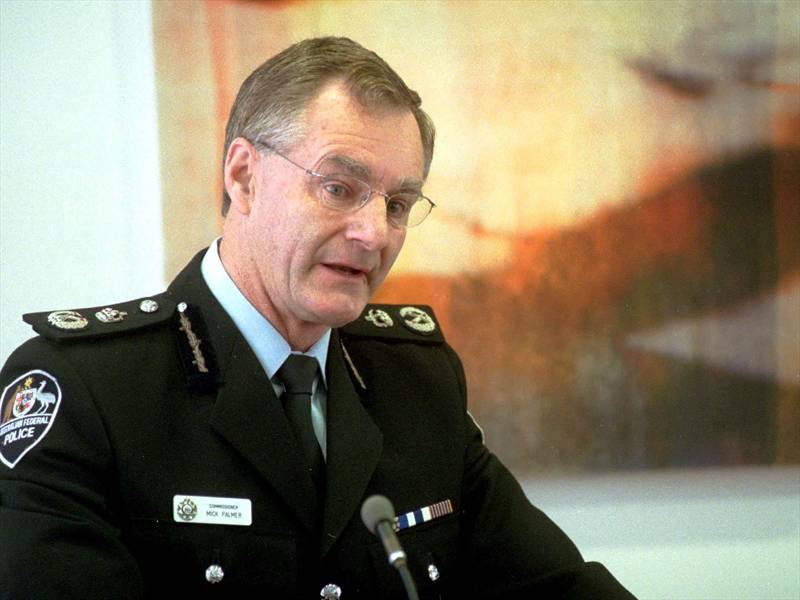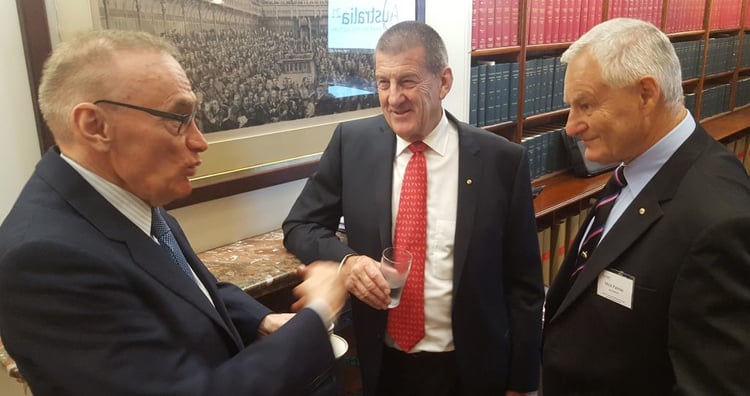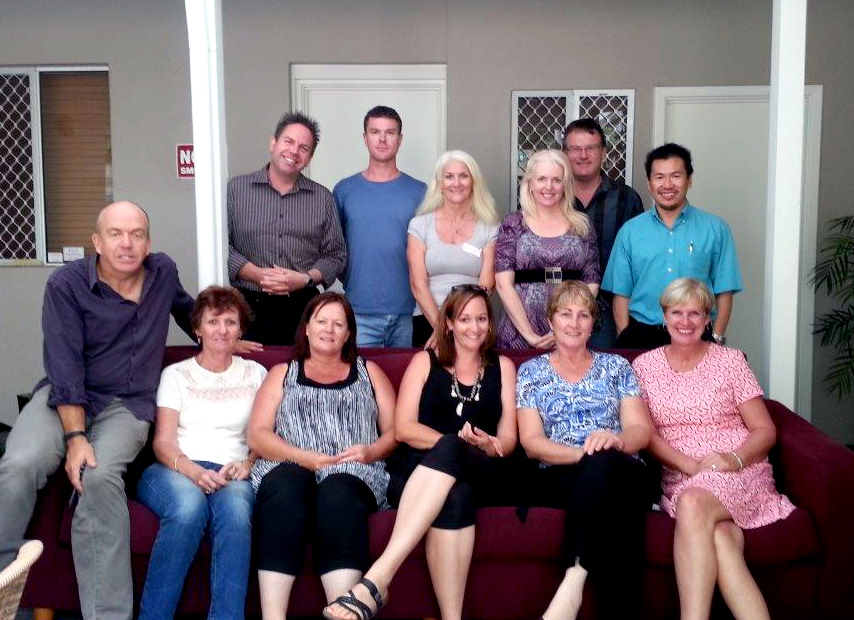Welcome mick palmer
Drug law reform advocate and former Federal Police Commissioner Mick Palmer becomes SMART Recovery Australia ambassador
SMART Recovery Australia is proud to announce Mick Palmer has joined the team as an official ambassador. Michael John Palmer AO, APM has been a barrister and 33 year career police officer with extensive experience in police leadership – including serving as the Commissioner of the Australian Federal Police. He has had an active interest in human rights and illicit drug reform.
We sat down with Mick to discuss how the former top cop changed his stance on drugs, what can be done to reduce harm related to addictive behaviours in the community, and why he is becoming an advocate for SMART Recovery Australia.
Q: As a former Commissioner of the Australian Federal Police, does the war on drugs work, and why/why not
My current attitude and opinion has been fashioned by a mix of experience and changed significantly over several years.
Essentially, I believe our current prohibitionist approach is badly broken, is ineffective and on reflection, probably always has been.
Despite the best endeavours of police, over many years, drugs are as readily available now as they have ever been. Experimentation is probably at an all-time high, with an ever widening array of drugs available for use; the market is totally unregulated and controlled by Organised Crime figures, and drug trafficking criminals, who make huge profits and pay no tax- and who follow no rules other than their own.
Additionally, the actual composition and quality of drugs being trafficked are totally unregulated and generally unknown, with buyers and users having no way of assessing or ascertaining the quality or toxicity– and often, even the actual product – which they are buying.
Drug dependent users are treated as criminals and so, all too often, are unlikely to confide in family or friends as to the cause of any medical problems arising from drug use when they occur – or to seek medical help- or if they do, to tell the truth about the likely cause of their sickness.
Despite the fact that police are probably more effective and better resourced now, than at any time in our history, law enforcement strategies clearly have had – and continue to have – little effect on illicit drug availability. Additionally, they are, unavoidably, discriminatory in that only a very small percentage of total users fall foul of the legal system.
The damage caused to the careers of those unfortunate enough to be apprehended may, however, be very substantial. As a consequence law enforcement outcomes are frequently counter-productive and operate to increase harm rather than reduce it.
I am in no way an apologist for illicit drug use and abhor drug traffickers and the harm they cause. Like many others, I am seriously disturbed by the damage and violence being caused by the ‘Ice epidemic’ impacting on Australia. But, even here, it is important to maintain perspective. Despite the publicity, it is estimated that only about 2% of Australians use ice and, as I understand the situation, the rate of usage is not markedly increasing, although prices are low and availability is probably at an all-time high, despite law enforcement’s best efforts.
I am convinced that our current approach is compounding rather than helping the problem and, indeed, the current publicity surrounding Ice is an illustration of this failure. Despite a huge investment in law enforcement resources on Ice related crime, Ice remains freely available, at relatively low cost to the street user. As Ken Lay, the head of then Prime Minister Abbott’s Ice Task force said ‘we can’t police – or arrest – our way out of this problem’. In my opinion he is absolutely right.
The reality is people will use drugs – both licit and illicit. They have always done so and will always do so. The issue is a health and social one and must be dealt with as such if we are to be effective in dealing with it.
Demand for, and the profits from, illicit drug sales are too high to provide policing with any real and genuine prospect of ever controlling supply or curbing demand.

Q: Given your former role in senior leadership of the Police force, how did you get to the point of advocating for things like pill testing? Have you always held these views, and if not, when and why did your opinion change?
I do strongly support and advocate for pill testing but I have not always held these views.
My attitude to illicit drugs and the futility of a prohibition approach to the problem of drug use, developed progressively over several years and was more evolutionary and revolutionary.
I initially had little sympathy for people who took illicit drugs or the consequences they suffered. However, time taught me lessons and hopefully a little wisdom. In my quite early days as a police officer on the street and then as a detective, I came to realise – and see firsthand – the harms caused by a criminal approach to drug users. I also became convinced that the risks associated with illicit drug use were aggravated by Australia’s prohibition focused Illicit Drug Policy rather than alleviated by them.
As a police officer and then practising barrister, I came to the realisation that the vast majority of drug using Australians – and particularly those who used recreationally – are thoroughly decent, generally young, men and women who were highly unlikely to come to the attention of police other than through their use of illicit drugs.
When pill testing began to gain exposure a few years ago I saw it, not as a drugs issue, but as a people issue.
People who bring drugs to a pill testing service already intend to take them.
Pill testing is the medical intervention that is often the final roadblock on the path to that decision; the final red light telling them to stop, wait, and maybe talk to someone who is in a position to give them expert and practical advice.
The whole idea of testing unregulated drugs is to improve an intended users’ knowledge so that, whatever decision they end up making regarding drugs, they are in a better, more informed position to do so. Pill testing puts people first, in particular their safety and well-being.
It is not about controlling levels of drug use, it is about reducing levels of danger and harm.
But there are wider benefits. Pill testing provides an opportunity for police, harm reduction workers, and young festivalgoers to work together to prevent adverse incidents at festivals. But it can only work if all stakeholders come to the table and cooperate.
Make no mistake – the role of police as a stakeholder in this context is absolutely vital, even more so in terms of their relationship with young people.
Street policing is overwhelmingly the responsibility of young policemen and women; officers about the same age, and with similar social habits, likes and dislikes to the people who attend festivals.
However, street policing is also unpredictable and potentially more dangerous than ever. Certainly the most dangerous in my 45-50 or so year’s association with police practice.
Never have young police officers needed the support and trust of young Australians – who frequent the locations and events that require street policing – more than now. Policing is essentially only as effective as the support and assistance it receives from the community.
But our drugs policy – particularly in regard to pill testing, and the enforcement of criminal penalties for use and possession – drives barriers and suspicions, and isolates police from their most important potential support base: instead they are forced to operate in a role of conflict and enforcement. Rather than being seen as trusted protectors of young, fun-loving, and otherwise law-abiding Australians, there to offer help and support, they are viewed with distrust, as only existing to arrest and punish. In some cases, to arrest and punish for conduct they themselves would engage in when off-duty.
The current approach motivates young Australians to tell police and other first responders’ lies or to hide the truth, when things go wrong and one of their friends suffers a medical episode. Current policy is almost aimed at achieving exactly that result. The cloud of stigma that continues to hover over drug use – perpetuated by police as an arm of the government – leaves young people at odds with the very people that can provide the most immediate help and support.
We have seen the benefits that result when the gap between police and the community is bridged. The pill testing services at Groovin’ the Moo in 2018 and earlier this year, had the full support of law enforcement, and would not have been able to succeed without it.
I now strongly believe that, rather than forcing police into the role of antagonist, governments need to remove criminal sanctions for use and possession, and support harm reduction measures like pill testing. They need to give police a chance to work productively with individuals and groups, and build the essential trust with young people that can be such a powerful influence on behaviour.
Police have a valuable role to play in protecting people – particularly young people – from harm. We need to give them the full opportunity to do so.

Q: What is it about SMART Recovery that you admire or align with?
The focus on self-help and self-worth, is what most draws me to SMART Recovery. The aim of treating people with respect, and respectfully, helping them to identify the tools and the means to deal with their problems and to recover, resonates with me. We need to give people the tools to help themselves if meaningful, long term, sustainable improvement and progress is to be made. In my assessment, SMART Recovery aims to do precisely that.
Q: How do you see yourself assisting SMART Recovery as an ambassador – what does success look like to you in this role?
I believe I can play a constructive part in raising the profile of SMART Recovery and the role they play, both through media interviews and the like and guest speaking engagements with groups such as Rotary, Lions and others.
There may also be opportunities to lobby government and other influential stakeholders.
I would also like, as far as this is consistent with SMART Recovery policy and process, to meet personally with clients and share experiences.
Q: As a former policeman and barrister, how have you seen addiction affect the community and to what extent? Are there any particular stories involving addiction from your career that resonate with you?
I have seen many instances of addiction tearing families apart and causing enormous grief and heartache. Two issues became evident to me, quite early on in my police career. One was that drug addiction is overwhelmingly likely to be a symptom of a deeper cause or causes and that policing almost only ever addresses the symptom. Secondly, due to the fact that drug use is illegal, users and addicts are frequently loathe to confide in their families or, often, even to friends, about their drug use problem or the fact of their addiction.
In regard to the first point, I have had personal dealings with numerous men and women with serious addiction problems, who are clearly suffering from serious mental illness, or the impacts of post-traumatic stress; who are unemployed – and in many cases have become almost unemployable –and devoid of any self-confidence or self-worth. Co-morbidity was an almost constant companion of addictive drug use wherever I witnessed it.
A close colleague of mine in my youth, who was a rugby league referee, had two teenage sons, both of whom became addicted to heroin due to a combination of learning and employment difficulties. Both sons had left home and were living independently but spoke frequently to their father. However, although having a close and loving relationship with their father, neither son confided in him about their drug habits, due to the shame they felt in their behaviour and the heartache they knew it would cause.
As a consequence their father believed they were still gainfully employed.
Both sons, still in their teens, died of heroin overdoses within months of each other, with the father discovering one of his sons sitting dead on a toilet seat with the needle still in his arm. This is a horror story, but sadly similar stories are repeated frequently in cities and towns all over Australia. It is the potential price we pay for isolating and demonising drug use and addiction.
Q: What is the best way for Australia to tackle addiction in the community moving forward?
I suggest a genuinely honest debate and assessment of current illicit drug policy, and the actual results and outcomes that have been – and are being – achieved, would be an excellent start: a debate which removes the fear and looks dispassionately, yet compassionately and objectively at the facts, the actual outcomes and the options.
Not even the strongest conservative, could be happy with the results we are currently achieving, or for that matter, have ever achieved under our tough on drugs mantle, despite the effort, the money and the good intentions that have gone into driving it. Other options must be considered, tried and tested.
These options, I suggest, should include:
Identifying and dealing with illicit drug use as a social and health issue NOT a criminal issue. Despite the very public examples of, sometimes extreme, violence linked to the use of ice, there is no sensible purpose to be served by attempting to address the ‘ice problem’ as a separate issue – or in isolation from other drugs.
Focusing law enforcement efforts solely on the production/ trafficking end of the market, where the benefits are likely to be highest and the harms to individual users the lowest.
Reviewing drug related funding so as to significantly Increase the funding for health and support services – improving and increasing diversionary, treatment and rehabilitation options. improving access to treatment and reducing the risk of overdoses and death.
Dealing with addicts and other users, as victims and/or patients not criminals – fostering and encouraging honest reporting – removing the stigma AND the negative discrimination.
Focusing attention on the underpinning causes, not simply the symptoms. Providing help and support not punishment.
Improving education, self-reliance and deterrence initiatives.
Assessing and identifying the options and staged pathways towards decriminalisation – first of cannabis and, if successful, of other drugs.
Considering particularly, as part of the above assessment, the options and means of regulation of supply – so as to better manage the quality, content and toxicity of the subject drugs, the regulatory control of the sale price and drug outlet points and the taxation of the profits.
As a consequence of having the courage to move to regulate the supply of certain drugs it is very likely, I suggest, that the size and profitability of the criminal market place would be materially reduced – something that prohibition has been unable to achieve over 70 plus years. Criminals are lazy; they go where the profits are largest and most easily obtained. They are involved in risk assessment and management like a legitimate business. If the going gets tough, history shows criminals get going – to somewhere else – or to some other product.
Whilst the illicit drug marketplace, and the consequent untaxed profits, remain owned and controlled by criminals, law enforcement will always be chasing its tail, regardless of the level of operational sophistication and the relative effectiveness of their efforts.
As starkly illustrated by the United States experience, without finding a way to reduce or remove the criminal marketplace, law enforcement is almost certainly doomed to failure in any attempt to police itself into a winning position.
If we are going to have a zero tolerance approach it should be a zero tolerance to the needless loss of any Australian life through illicit drug use.
We need to remember that the central plank or aim of our current illicit drugs policy is “Harm Minimisation” and we should measure the success of our policy and processes against that criteria. Sadly, both currently and historically, against any measure, we have failed miserably in our attempts to achieve this aim and indeed many aspects of current policy actually aggravate harms rather than reduce them, particularly to addicts and the most vulnerable in our society.
I was AFP Commissioner when John Howard launched his “Tough on Drugs” policy – and the AFP benefitted from the money and focus on supply reduction. But, John Howard also allocated very significant money and emphasis to diversion and treatment programs.. Although it branded its drug policy as ‘Tough on Drugs’, the Howard Government was much more pragmatic than that. It was the first Commonwealth government to provide funding to the states and territories to improve their needle syringe programs.
It also funded the diversion of many people convicted of drug offences from the criminal justice system to drug treatment and generously funded harm reduction in Asia to stop HIV spreading from people who inject drugs to the general community.
As a fundamental but, I believe critically important, early step, we must work to create a climate where it is safe to talk about drugs, where parents feel comfortable having the conversation with their kids over a backyard Bar-B-Q or around the dinner table.
We must recognise that any change will need to be gradual and “politically pragmatic” to be successful.
Although some of the following have already been mentioned in my answer, I thought it worthwhile, without pretending to be an expert in the field, the more specific steps I believe should be considered:
Analyse the actual results achieved under our zero tolerance – Tough on Drugs – approach and honestly assess the results achieved – good, bad and ugly;
Recognise that, to improve its effectiveness, Australia’s illicit drug policy must be reframed as primarily a health and safety and social issue, within which the health and well-being of people, not the level of drug use, is the primary and over-riding aim and driving force.
Develop strategies to better understand the health and well-being dangers to addicts and social users, which arise from them purchasing (often tainted or corrupted) drugs from a totally unregulated black market and then being treated as criminals for doing so.
Have the courage to trial new approaches, including nationally consistent decriminalisation and regulation of supply, but do so gradually and incrementally, with care taken to ensure that the community understands the research and the reasons and benefits underpinning the changes and supports the journey as it unfolds.
Amend the policing role to a more targeted support role, aimed at the organised trafficking criminal marketplace, where the benefits of police intervention are highest and the risks and dangers, particularly to the most vulnerable in our society, are lowest.
Incremental steps could include:
Adopting a firm national strategy that puts the health and safety of people, many of whom are young, first and foremost on the National Agenda and ceases criminalising people for simple use and possession of drugs.
Introducing a policy that clearly distinguishes between anti-social behaviour and the drug use that may have contributed to it. Punishing the criminal behaviour – but treating the drug use.
Implementing a policy that aims to engage with and support addicts and other drug users, not isolate and punish them.
Increase funding of treatment options for people with drug use and addiction problems to a level sufficient to create the capacity, quality, and flexibility of treatment options to meet realistic demand.
Consider the establishment – on a trial basis – of ‘Controlled Drug Monitoring Rooms’ to assist in containing, managing and reducing episodes of drug abuse and the consequent likely harms and better educating or informing drug users of the dangers inherent in their behaviour.
Agree, nationally, to commence trial drug testing of pills at festivals and similar public gatherings with a view to encouraging users to –
Become more aware of the quality and toxicity of the drug they are planning to use, and the dangers, including the dangers of addiction, the drugs may pose,
Minimise or reduce potential harms and create an environment to change behaviours.
And assess the results.
Conclusion
Of course, any review and reform process must include a strong strategy to engage with the public. Community support will be crucial to the achievement of meaningful improvement in drug policy and improved outcomes.
Unquestionably, perceptions of community fear drive political resistance to change. As a leading European politician said some years ago: “We all know what to do, we just don’t know how to get re-elected after we do it”.
The potential benefits of a genuine community conversation are, however, almost endless. To engage through open dialogue in an holistic assessment of the state of play within Australia; to explore and examine the linkages between such issues as mental health; domestic violence; homelessness; chronic unemployment and drug use and addiction, would be an exercise with no down-side. One from which we could only learn valuable lessons.
The views and opinions of authors expressed herein do not necessarily state or reflect those of SMART Recovery Australia.
Subscribe to our newsletter
Don't miss new updates on your email
Help us save lives
Your contribution goes straight to work helping tens of thousands of Australians through our support programs, which empower people affected by problematic addictive behaviours to make positive life changes – often life saving.


